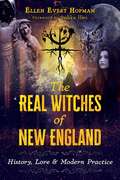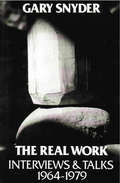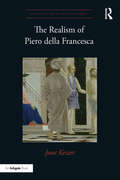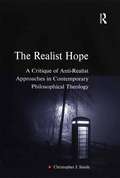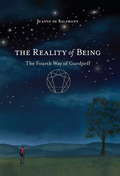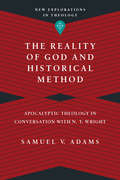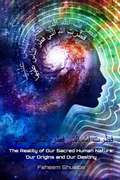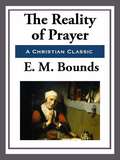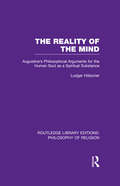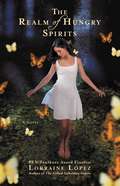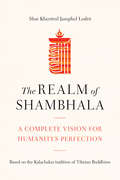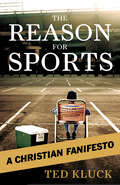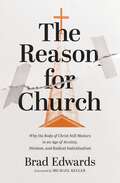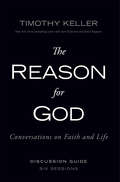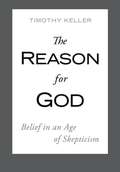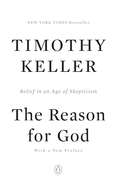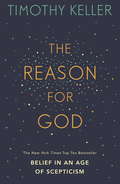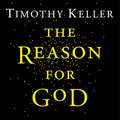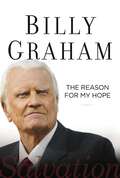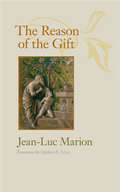- Table View
- List View
The Real Witches of New England: History, Lore, and Modern Practice
by Ellen Evert Hopman Judika IllesReveals the origins and history of the New England witch hysteria, its continuing repercussions, and the multilayered practices of today’s modern witches • Shares the stories of 13 accused witches from the New England colonies through interviews with their living descendants • Explores the positive role witches played in rural communities until the dawn of the industrial age, despite ongoing persecution • Includes in-depth interviews with 25 modern witchcraft practitioners, interwoven with practical information on the sacred calendar, herb lore, spells, and magical practices New England has long been associated with witches. And while the Salem witch trials happened long ago, the prejudices and fears engendered by the witchcraft hysteria still live on in our culture. What forces were at work that brought the witch hysteria quickly from Europe to the new American colony, a place of religious freedom--and what caused these prejudices to linger centuries after the fact? Weaving together history, sacred lore, modern practice, and the voices of today’s witches, Ellen Evert Hopman offers a new, deeper perspective on American witchcraft and its ancient pagan origins. Beginning with the “witch hysteria” that started in Europe and spread to the New World, Hopman explores the witch hunts, persecutions, mass hysteria, and killings, concluding that between forty and sixty thousand women and men were executed as witches. Combining records of known events with moving interviews with their descendants, she shares the stories of 13 New England witches persecuted during the witch trials, including Tituba and Mary Bliss Parsons, the Witch of Northhampton. Despite the number of false accusations during the witch hysteria in the New England colonies, Hopman reveals how there were practicing witches during that time and describes the positive role witches played in rural communities until the dawn of the industrial age. Exploring how the perception and practices of witches has evolved and expanded over the centuries, Hopman also includes in-depth interviews with 25 modern-day practitioners from a variety of pagan faiths, including druids, wiccans, Celtic reconstructionists, and practitioners of the fairy faith. Emerging from their insights is a treasure trove of practical information on the sacred calendar, herb lore, spells, and magical practices. Bringing together past and present, Hopman reveals what it really means to be a “witch,” redefining the label with dignity and spiritual strength.
The Real Work: Interviews and Talks, 1964-79
by Gary Snyder William Scott McleanAmerican poet Gary Snyder on poetics, tribalism, ecology, Zen Buddhism, meditation, the writing process, and more. The Real Work is the second volume of Gary Snyder’s prose to be published by New Directions. Where his earlier Earth House Hold(1969) heralded the tribalism of the "coming revolution," the interviews in The Real Work focus on the living out of that process in a particular place and time––the Sierra Nevada foothills of Northern California in the 1970s. The talks and interviews collected here range over fifteen years (1964-79) and encompass styles as different as those of the Berkeley Barb and The New York Quarterly. A "poetics of process" characterizes these exchanges, but in the words of editor Mclean, their chief attraction is "good, plain talk with a man who has a lively and very subtle mind and a wide range of experience and knowledge."
The Real World of Fairies: A First-Person Account
by Caitlin Matthews Dora van Gelder Kunz"If we are patient and courteous, we too can find fairy allies in the wild places of nature, in the secret pathways of our dreams, in the deep wisdom of the ancient and ancestral traditions of our land, as Dora van Gelder has demonstrated." -- from the foreword by Caitlin MatthewsThe Real World of Fairies is a privileged glimpse into a joyous, animated universe. Dora's enchanting vision of her encounters with the fairy realm delights the child in us, while it excites our grown-up imagination, rekindles our creative energy, and deepens our sense of connection with nature.This new edition features a foreword by Celtic folk expert Caitlin Matthews. Caitlin's personal experiences and deep knowledge of the fairy world resonate brilliantly with Dora's, adding a fresh perspective for contemporary readers.
The Realism of Piero della Francesca: Life And Work (Visual Culture in Early Modernity)
by Joost KeizerThe fifteenth-century Italian artist Piero della Francesca painted a familiar world. Roads wind through hilly landscapes, run past farms, sheds, barns, and villages. This is the world in which Piero lived. At the same time, Piero’s paintings depict a world that is distant. The subjects of his pictures are often Christian and that means that their setting is the Holy Land, a place Piero had never visited. The Realism of Piero della Francesca studies this paradoxical aspect of Piero’s art. It tells the story of an artist who could think of the local churches, palaces, and landscapes in and around his hometown of Sansepolcro as miraculously built replicas of the monuments of Jerusalem. Piero’s application of perspective, to which he devoted a long treatise, was meant to convince his contemporaries that his paintings report on things that Piero actually observed. Piero’s methodical way of painting seems to have offered no room for his own fantasy. His art looks deliberately styleless. This book uncovers a world in which painting needed to validate itself by cultivating the illusion that it reported on things observed instead of things imagined by the artist. Piero’s painting claimed truth in a world of increasing uncertainties.
The Realist Hope: A Critique of Anti-Realist Approaches in Contemporary Philosophical Theology (Heythrop Studies in Contemporary Philosophy, Religion and Theology)
by Christopher J. InsoleTaking into consideration analytical, continental, historical, post-modern and contemporary thinkers, Insole provides a powerful defence of a realist construal of religious discourse. Insole argues that anti-realism tends towards absolutism and hubris. Where truth is exhausted by our beliefs about truth, there is no conceptual space for doubting those beliefs; only a conception of truth as absolute, given and accessible can guarantee the very humility, sense of fallibility and sensitivity to difference that the anti-realist rightly values. Cutting through some of the tired and well-rehearsed debates in this area, Insole provides a fresh perspective on approaches influenced by Wittgenstein, Kant, and apophatic theology. The defence of realism offered is unusual in being both analytically precise, and theologically sensitive, with a view to some of the wider and less well-explored cultural, ethical and political implications of the debate.
The Reality of Being: The Fourth Way of Gurdjieff
by Jeanne De SalzmannAs the closest pupil of the charismatic spiritual master G. I. Gurdjieff (1866-1949), Jeanne de Salzmann was charged with carrying on his teachings of spiritual transformation. Known as the Fourth Way or "the Work," Gurdjieff's system was based on teachings of the East that he adapted for modern life in the West. Now, some twenty years after de Salzmann's death, the notebooks that she filled with her insights over a forty-year period (and intended to publish) have been translated and edited by a small group of her family and followers. The result is this long-awaited guide to Gurdjieff's teaching, describing the routes to be traveled and the landmarks encountered along the way. Organized according to themes, the chapters touch on all the important concepts and practices of the Work, including:awakening from the sleep of identification with the ordinary level of beingself-observation and self-rememberingconscious effort and voluntary sufferingunderstanding symbolic concepts like the Enneagramthe Gurdjieff Movements, bodily exercises that provide training in Presence and the awareness of subtle energiesthe necessity of a "school," meaning the collective practice of the teaching in a groupMadame de Salzmann brings to the Work her own strong, direct language and personal journey in learning to live that knowledge of a higher level of being, which, she insists, "you have to see for yourself" on a level beyond theory and concept. De Salzmann consistently refused to discuss the teaching in terms of ideas, for this Fourth Way is to be experienced, not simply thought or believed.
The Reality of God and Historical Method: Apocalyptic Theology in Conversation with N. T. Wright (New Explorations in Theology)
by Samuel V. AdamsAfter a flurry of heated debates in the mid-twentieth century over the relationship between faith and history, the dust seems to have settled. The parties have long since dispersed into their separate camps. The positions are entrenched and loyalties are staked out. This first volume in the New Explorations in Theology is a deliberate attempt to kick up the dust again, but this time as a constructive development of what is now being called "apocalyptic theology." Samuel Adams argues that any historiography interested in contributing to theological knowledge must take into consideration, at a methodological level, the reality of God that has invaded history in Jesus Christ. He explores this idea in critical dialogue with the writings of New Testament historian and theologian N. T. Wright, whose work has significantly shaped the current conversation on this problem. The Reality of God and Historical Method is a fresh, bold and interdisciplinary exploration of the question: How is it possible to say that a particular historical person is the reconciliation of the world?
The Reality of Our Sacred Human Nature: Our Origins and Our Destiny
by Imam ShuaibeTHE REALITY OF OUR SACRED HUMAN NATURE “The Reality of Our Sacred Human Nature” is the first book to be written upon a research methodology found in the first three verses of the 87th Chapter of the Holy Qur’an. Those verses, when understood and applied to researching any subject matter, call for knowing four particular things about the object of your research: #1. The form of the object of your research. #2. Its place within a system, particular and universal. #3. Its potential to grow from simple to complex. #4. Its place in the guidance of G’d. When these four things are understood about anything, the one who possesses that knowledge knows everything about that thing. The great call in the pursuit of sacred wisdom is summarized in the command “Know Thyself.” Since human nature is the cornerstone of our existence, Imam Faheem applied this research methodology to the study of our Common, Sacred Original Human Nature.
The Reality of Prayer
by E. M. BoundsPray, Pray and Pray some more! God loves it and the Devil hates it. In The Reality of Prayer Bounds explores how prayer is A Privilege, Princely & Sacred, how it Fills Man's Poverty with God's Riches, Our Lord's Model Prayer, The Holy Spirit and Prayer and much more. The word "Prayer" expresses the largest and most comprehensive approach unto God. It gives prominence to the element of devotion. It is communion and intercourse with God. It is enjoyment of God. It is access to God. "Supplication" is a more restricted and more intense form of prayer, accompanied by a sense of personal need, limited to the seeking in an urgent manner of a supply for pressing need. "Supplication" is the very soul of prayer in the way of pleading for some one thing, greatly needed, and the need intensely felt. E. M. Bounds offered perhaps a more profound understanding of prayer than any other contemporary Christian thinker. His classic books on the personal communication with God explore how prayer must come from the whole being and strengthens faith in Christian lives. Edward McKendree Bounds was a clergyman of the Methodist Episcopal Church South and author of eleven books, nine of which focused on the subject of prayer. Bounds was a practicing lawyer at age nineteen and after three years, began preaching for the Methodist Episcopal Church, South. At the time of his pastorate in Brunswick, Missouri, war was declared. Bounds became a prisoner of war after refusing to take the oath of allegiance to the Federal Government. Upon release he served as chaplain of the Fifth Missouri regiment until the close of the war.
The Reality of the Mind: St Augustine's Philosophical Arguments for the Human Soul as a Spiritual Substance (Routledge Library Editions: Philosophy of Religion)
by Ludger HölscherAmong the various approaches to the question of the nature of the mind (or soul), Augustine’s philosophical arguments for the existence of an incorporeal and spiritual substance in man and against materialism are here thoroughly examined on their merits as a source of insight for contemporary discussion. This book, originally published in 1986, employs Augustine’s method of introspection, and argues that, as a philosopher, Augustine can teach the modern mind how to detect the reality of such a spiritual subject in and through basic human acts and faculties, such as imagination, memory, knowledge, free-will and self-knowledge. It presents a critical dialogue with various materialistic anthropologies directly addressed by Augustine himself, or those which have arisen at later periods, including epiphenomenalism, mind-brain identity theory, Marxism and others.
The Realm of Hungry Spirits
by Lorraine LópezIn Buddhism, there is a place where hungry souls gather between lives awaiting rebirth so they can finally satisfy the desires that haunt them. In the San Fernando Valley, that place is Marina Lucero's house. For Marina Lucero, whose father transformed his life through meditation and whose mother gave hers to a Carmelite convent, spirituality should come easily. It doesn't. After a devastating relationship leaves her feeling lost and alone, she opens her home to a collection of wayward souls-- the abused woman next door and her alcoholic sister, her aimless nephew and his broken-hearted best friend. Her house now full but her heart still empty, Marina then turns to the wisdom of Gandhi, the Dalai Lama, even a Santeria priest who wants to cleanse her home. As Marina struggles to balance the disappointments and delights of daily life, she'll learn that, when it comes to inner peace and those we love, a little chaos can lead to a lot of happiness.
The Realm of Shambhala: A Complete Vision for Humanity's Perfection
by Shar Khentrul LodröA comprehensive account of Shambhala according to the Jonang school of Tibetan Buddhism.The Realm of Shambhala presents the Kalachakra Tantra's multilayered approach to Shambhala as taught by the Tibetan Buddhist Jonang tradition. Understood to be an ancient kingdom and physical place, Shambhala is also taught to be an exalted state of mind attainable through spiritual practices. Through cultivating peace and extending it into harmonious relationships with others, the transformative power of Shambhala can enter everyday life. This book provides a concise history and analysis of the term "Shambhala" as received in the Western world and provides a new interpretation of much-debated scriptural passages. It then details the tradition's perspective on the origins of Kalachakra literature and includes extensive lineage narratives of Jonang masters who have upheld this tradition in India and Tibet.Khentrul Rinpoche provides a thorough explanation of Shambhala that joins practical teachings with a cosmic vision for humanity rooted in ancient prophecy. The Kalachakra Tantra foresees a golden age of love and compassion, when the individual peace attained through Kalachakra practice spreads to humankind as a whole. The Realm of Shambhala lays out a vision for how we can cultivate an unbiased mind, overcome our collective afflictions, and usher in an era of perfect peace and harmony.
The Realms Thereunder (The Ancient Earth Trilogy #1)
by Ross LawheadAncient legend tells of an army of knights that will remain sleeping until the last days. The knights are waking up.A homeless man is stalked by a pale, wraithlike creature with a mouthful of needle-sharp teeth. Maimed animals and a host of suicides cluster around a mountain in Scotland. And deep beneath the cobbled streets of Oxford, a malicious hoard besieges a hidden city.Freya Reynolds is a university student with a touch of OCD and an obsession with myth and folklore. Daniel Tully is living rough on the streets of Oxford, waging a secret war against an enemy only he can identify. Years ago, they found themselves in a world few know is real. They have since gone their separate ways and tried to put that adventure behind them.But the mythical world is now bleeding into our reality—a dark spiritual evil that is manifesting itself in forgotten corners of the British Isles. Alex Simpson is a Scottish police officer who specializes in hunting mythical creatures. Together, they must confront the past, the present, and points beyond to defeat the ultimate threat to humanity.Nothing they've seen so far prepares them for what awaits . . . in The Realms Thereunder.
The Reason
by William SirlsWhen facing the impossible, will you believe?Storm clouds gather over a small Michigan town. As thunder shakes the sky, the lights inside St. Thomas Church flicker . . . and then go out.All is black until a thick bolt of lightning slices the sky, striking the church's large wooden cross--leaving it ablaze and splintered in two.When the storm ends--the search for answers begins.James Lindy, the church's blind minister, wonders how his small congregation can repair the cross and keep their faith in the midst of adversity. And he hears the words "only believe."Macey Lewis, the town's brilliant young oncologist, is drawn to Alex, a young boy who's recently been diagnosed with an aggressive leukemia. She puts her hope in modern medicine--yet is challenged to "only believe."And Alex's single mom, who has given everything she can to her boy, is pleading with God to know the reason this is happening . . . to save her son. But she only hears silence and wonders how she can possibly "only believe."The Reason is a milestone debut novel, opening with a thunderbolt and never letting up as it introduces us to everyday characters who are wrestling with the questions: Where is God when bad things happen? And does God ignore the prayers of the faithful? The answer each character receives will astound readers while offering an unforgettable call to hope, to change, to . . . only believe."This is a skillfully written first novel with the narrative voice, knack for dialogue, and plot movement of a veteran author." --Publishers Weekly
The Reason For Sports: A Christian Fanifesto
by Ted KluckThere are books on how to worship God with our marriages, our money, and our sex lives. Books on how to &“think biblically&” about movies, television, and the arts. Books on how to vote Christianly and how not to vote Christianly. But there is little thoughtful, Christ-centered writing on the subject that drives most of men&’s banter with each other and consumes the bulk of their free time- Sports.Written in the vein of Rick Reilly (Sports Illustrated), Chuck Klosterman (Spin, Esquire), and David Foster Wallace (A Supposedly Fun Thing I&’ll Never Do Again), The Reason for Sports will both entertain and shed light on some of today&’s most pertinent sports issues (race, drugs, hero worship, and more)- all through a biblical lens.e drowns puppies, or that you should cheer for all American QB Tim Tebow because he etches a Bible verse on his eye-black before every game. I&’ll let you draw your own conclusions about all of these people. But I&’ll invite you to begin formulating your own theology of sports with me.
The Reason For Sports: A Christian Fanifesto
by Ted KluckThere are books on how to worship God with our marriages, our money, and our sex lives. Books on how to &“think biblically&” about movies, television, and the arts. Books on how to vote Christianly and how not to vote Christianly. But there is little thoughtful, Christ-centered writing on the subject that drives most of men&’s banter with each other and consumes the bulk of their free time- Sports.Written in the vein of Rick Reilly (Sports Illustrated), Chuck Klosterman (Spin, Esquire), and David Foster Wallace (A Supposedly Fun Thing I&’ll Never Do Again), The Reason for Sports will both entertain and shed light on some of today&’s most pertinent sports issues (race, drugs, hero worship, and more)- all through a biblical lens.e drowns puppies, or that you should cheer for all American QB Tim Tebow because he etches a Bible verse on his eye-black before every game. I&’ll let you draw your own conclusions about all of these people. But I&’ll invite you to begin formulating your own theology of sports with me.
The Reason Sixty: Second Edition
by Joseph J. LoizzoPresents two key Indian Buddhist philosophical masterpieces that integrate the Buddhist ethos of wisdom and compassion, with their profound relevance to contemporary thought clarified by a renowned scholar of contemplative science.This volume contains English translations of two critical treatises of the Middle Way (Madhyamaka) Buddhist philosophical school: the Reason Sixty, by the most important of Indian thinkers, Nagarjuna (2nd CE), and the commentary by his most influential successor, Chandrakirti (7th CE). These two treatises emphasize the non-foundationalist reasoning for which Madhyamaka thought is famed, here within the context of that quintessential Buddhist topic, universal compassion, thereby illuminating the nondual nature of these two fundamental components of Indian Buddhist thought. The full import of Nagarjuna&’s verses are brought to life by Chandrakirti, whose influence in Tibetan Buddhist educational institutions remains profound to the present. Translator Joseph Loizzo, a Harvard-trained psychiatrist and Columbia-trained Buddhologist, elucidates the relevance of these two treatises to the linguistic turn in contemporary philosophy and emphasizes their practical, therapeutic possibilities. Comparing, in particular, the deep resonances between Chandrakirti&’s commentary and Wittgenstein&’s later work, Loizzo presents a masterful analysis in cross-cultural thought that highlights the transformative potential of philosophy.
The Reason for Church: Why the Body of Christ Still Matters in an Age of Anxiety, Division, and Radical Individualism
by Brad EdwardsRediscover the goodness and beauty of the Body of Christ.The evangelical church is hemorrhaging. Over 40 million Americans have dechurched in the last 25 years alone, and multiple generations have been raised to believe the most spiritual thing they can do is follow God by following their heart--right out of the church. Yet, this shift is happening right as society is hitting record levels of loneliness, stress, and anxiety. In The Reason for Church, pastor Brad Edwards connects the dots of our current church crisis and provides compelling reasons to come back.In part 1, Edwards shows how individualistic beliefs make church implausible and compromise our spiritual formation:Marketplace logic and consumeristic approaches to discipleshipIntuitional spirituality and therapy speakSocial media's distortion of what is true, good, and beautifulPerformative politics and culture warsVirtuous victimhood, the decline of trust, and the rise of powerThese chapters show why individualism won't satisfy and can't provide the refuge it promises.In part 2, Edwards uses personal examples, church history, non-Western expressions of faith, and Scripture to show how the church is our existentially satisfying alternative to individualism. Equipped with an institutionally robust vision, we will rediscover the church as God's spiritual greenhouse where soul-tired sojourners and lonely exiles are restored and repurposed for life in the world.The Reason for Church offers an honest-yet-hopeful vision for church as a necessary institution. With radical individualism tearing us apart, we need compelling reasons to fall back in love with Christ's bride, now more than ever.
The Reason for God Discussion Guide: Conversations on Faith and Life
by Timothy KellerIn the New York Times bestselling book The Reason for God, Timothy Keller established himself as a modern-day C. S. Lewis who brings together faith and intellect, theology and popular culture, modern-day objections and historic Christian beliefs. Now fans of the book will find resources to help them engage with those same objections, drawing on recent scholarship and debates. The Reason for God video-based Bible study can be used individually, in groups, or by any believer who is engaging with friends who don’t share his or her beliefs. Christians will be challenged to wrestle with their friends and neighbors’ hardest questions, and to engage those questions in ways that will spark an honest, enriching, and humbling dialogue. The Reason for God video captures a live and unscripted conversation between Timothy Keller and six panelists discussing their objections to Christianity. This discussion guide will help small groups and individuals dig deeper into these objections and learn about both sides of the issues. Study Details: Session Titles and Descriptions: 1. Isn’t the Bible a Myth? 2. How Can You Say There Is Only One Way to God? 3. What Gives You the Right to Tell Me How to Live My Life? 4. Why Does God Allow Suffering? 5. Why Is the Church Responsible for So Much Injustice? 6. How Can God Be Full of Love and Wrath at the Same Time? Awards: 2011 Christian Retailers Choice award for Curriculum (Nontraditional) 2011 Outreach Magazine Resources of the Year for Small Group (Curricula)
The Reason for God: Belief in an Age of Skepticism
by Timothy KellerKeller explains how faith in a Christian God is a soundly rational belief, held by thoughtful people of intellectual integrity with a deep compassion for those who truly want to know the truth.
The Reason for God: Belief in an Age of Skepticism
by Timothy KellerA New York Times bestseller people can believe in—by "a pioneer of the new urban Christians" (Christianity Today) and the "C.S. Lewis for the 21st century" (Newsweek). Timothy Keller, the founding pastor of Redeemer Presbyterian Church in New York City, addresses the frequent doubts that skeptics, and even ardent believers, have about religion. Using literature, philosophy, real-life conversations, and potent reasoning, Keller explains how the belief in a Christian God is, in fact, a sound and rational one. To true believers he offers a solid platform on which to stand their ground against the backlash to religion created by the Age of Skepticism. And to skeptics, atheists, and agnostics, he provides a challenging argument for pursuing the reason for God.Look out for Timothy Keller's latest book, The Songs of Jesus. From the Trade Paperback edition.
The Reason for God: Belief in an age of scepticism
by Timothy KellerAs the pastor of an inner-city church in New York City, Timothy Keller has compiled a list of the most frequently voiced ‘doubts’ sceptics bring to his church, as well as the most important reasons for faith. In THE REASON FOR GOD, he addresses each doubt and explains each reason.Keller uses literature, philosophy, real-life conversations, and reasoning to explain how faith in a Christian God is a soundly rational belief, held by thoughtful people of intellectual integrity with a deep compassion for those who truly want to know the truth.
The Reason for God: Belief in an age of scepticism
by Timothy KellerAs the pastor of an inner-city church in New York City, Timothy Keller has compiled a list of the most frequently voiced 'doubts' sceptics bring to his church, as well as the most important reasons for faith. In THE REASON FOR GOD, he addresses each doubt and explains each reason. Keller uses literature, philosophy, real-life conversations, and reasoning to explain how faith in a Christian God is a soundly rational belief, held by thoughtful people of intellectual integrity with a deep compassion for those who truly want to know the truth.(P)2008 Penguin Audiobooks
The Reason for My Hope: Salvation
by Billy GrahamWhat is the most hopeful word in History? For Billy Graham, that word is SALVATION. Salvation from what? From our selfish and self-destructive selves. From the messes we get ourselves into. From the sin that has haunted humanity from the beginning of time and the evil that pulls us down every day. From the cultural deceits that blind us to God's saving message. From the Hell so many don't believe in. If we don't think we need salvation, we're fooling ourselves.If we think we are beyond salvation, we're underestimating God.If we just don't want to think about salvation, we're putting ourselves in eternal peril. At the age of ninety-five Billy Graham proclaims God's Gospel with resolve and deep compassion. It is a message he has been preaching for more than seventy years. And in this book you will sense its urgency, filled with hope for the future. "Believe on the Lord Jesus Christ, and you will be saved" (Acts 16:31) From America's evangelistic elder statesman: Salvation is what we all long for, when we are lost or in danger or have made a mess of our lives. And salvation belongs to us, when we reach out for the only One who can rescue us, Jesus. The saving message of the Gospel is the heartbeat of this preacher and evangelist. Millions around the world have heard Billy Graham proclaim this unchanging truth. He has never forgotten the transformation of his own life, when he first said yes to God's gift of salvation, and he has witnessed multitudes turn their hearts to the God of Hope. The Reason for My Hope: Salvation presents the essence of that transformative message. It is biblical and timeless, and though simple and direct, it is far from easy. There are hard words, prophetic words, directed toward a culture that denies the reality of sin and distracts us from the veracity of Hell. But through its ominous warnings shines a light that cannot be extinguished, a beacon of hope that Jesus came to seek and to save that which was lost. (Luke 19:10).
The Reason of the Gift (Richard Lectures)
by Jean-Luc Marion Stephen E. LewisThis book represents a continuation of Jean-Luc Marion's work on givenness as a foundational concept. A former student of Jacques Derrida, Marion is known for his work in seventeenth-century French philosophy, for his theory of "God without being," and for his reformulation of phenomenology. Marion's groundbreaking work on givenness is articulated through attentive readings in a striking array of philosophical texts. The four pieces collected here, based on the fall 2008 Richard Lectures at the University of Virginia, expand upon and go beyond the lines of Marion's previous work and exemplify the intersection of his own constructive brilliance with his talent and rigor as a historian of philosophy. Reengaging philosophers long central to Marion's own work (Husserl, Heidegger, Levinas) and highlighting the significance of lesser-known but decisive influences (Natorp, Rickert, Meinong), these lectures will be valuable to readers interested in the ongoing conversation seeking to bridge the divide between Continental and analytic philosophies, particularly through the exploration of common points of origin. These pieces tackle some of the most pressing debates in contemporary European philosophy and offer students of Marion material to ponder as they seek to further understand his influences. Taken together, these essays form an important volume by a major figure in contemporary philosophy.
